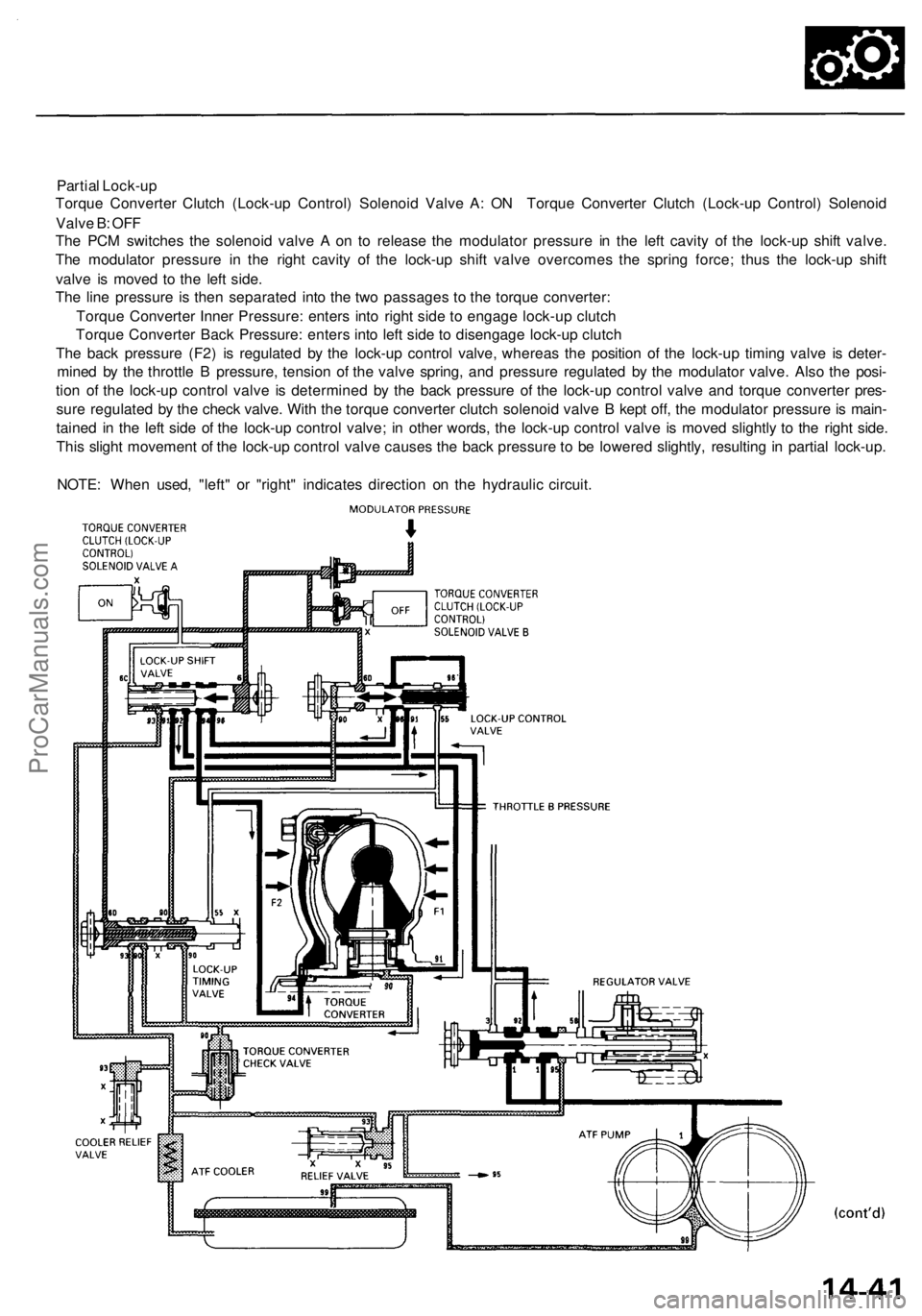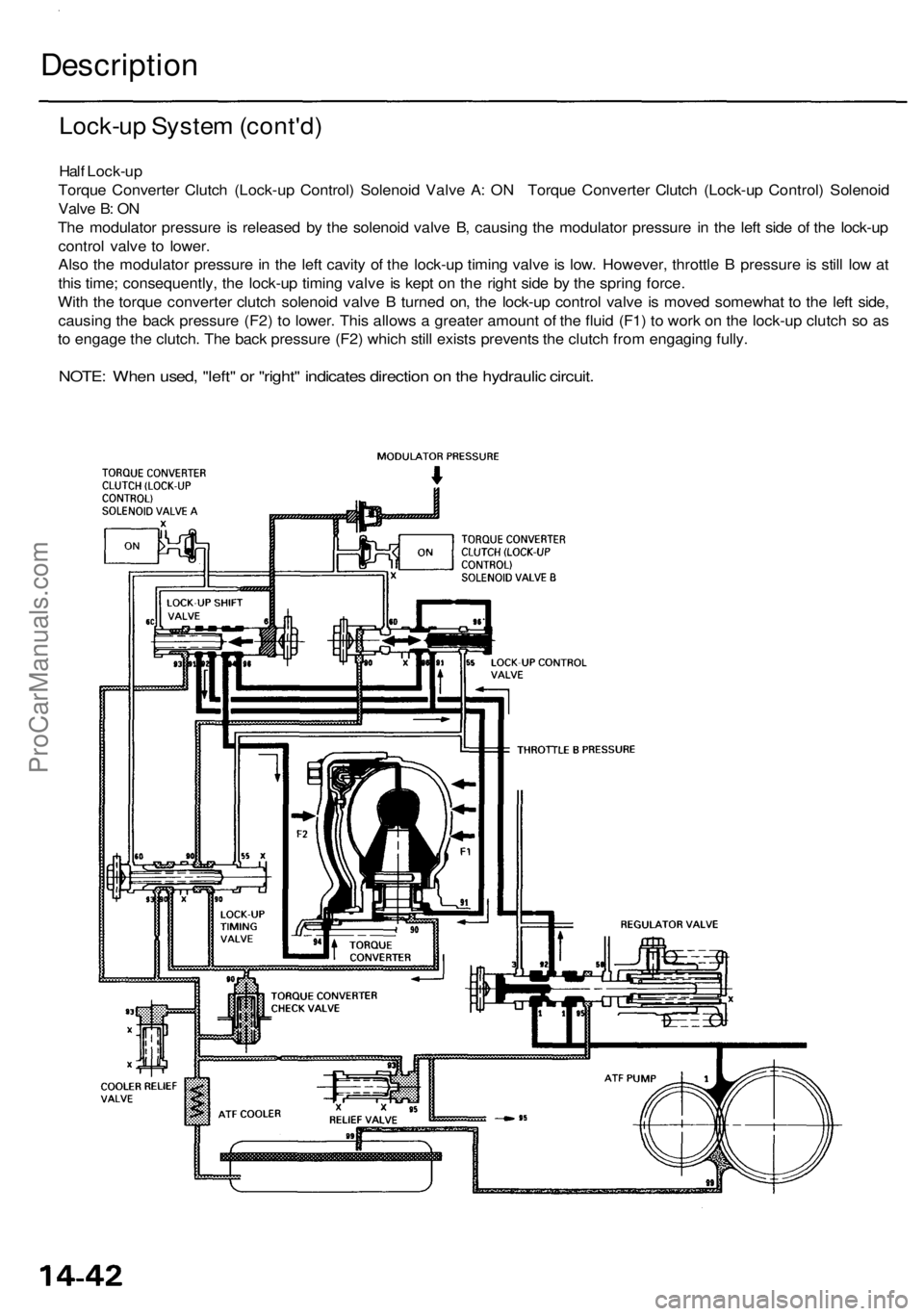Page 748 of 1954
In position in 2nd, 3rd and 4th, and position in 3rd, pressurized fluid is drained from the back of the torque converter
through a passage, causing the lock-up piston to be held against the torque converter cover. As this takes place, the main-
shaft rotates at the same speed as the engine crankshaft. Together with hydraulic control, the PCM optimizes the timing of
the lock-up system. Under certain conditions, the lock-up clutch is applied during deceleration in 3rd and 4th gear.
The lock-up system controls the range of lock-up according to torque converter clutch (lock-up control) solenoid valves A
and B, and the throttle valve. When torque converter clutch solenoid valves A and B activate, modulator pressure
changes. Torque converter clutch solenoid valves A and B are mounted on the torque converter housing, and are con-
trolled by the PCM.
NOTE: When used, "left" or "right" indicates direction on the hydraulic circuit.ProCarManuals.com
Page 749 of 1954
Description
Lock-up System (cont'd)
No Lock-up
The pressurized fluid regulated by the modulator works on both ends of the lock-up shift valve and on the left side of the
lock-up control valve. Under this condition, the pressures working on both ends of the lock-up shift valve are equal, and
the shift valve is moved to the right side by the tension of the valve spring alone. The fluid from the pump will flow
through the left side of the lock-up clutch to the torque converter; that is, the lock-up clutch is in OFF condition.
NOTE: When used, "left" or "right" indicates direction on the hydraulic circuit.ProCarManuals.com
Page 750 of 1954

Partial Lock-up
Torque Converter Clutch (Lock-up Control) Solenoid Valve A: ON Torque Converter Clutch (Lock-up Control) Solenoid
Valve B: OFF
The PCM switches the solenoid valve A on to release the modulator pressure in the left cavity of the lock-up shift valve.
The modulator pressure in the right cavity of the lock-up shift valve overcomes the spring force; thus the lock-up shift
valve is moved to the left side.
The line pressure is then separated into the two passages to the torque converter:
Torque Converter Inner Pressure: enters into right side to engage lock-up clutch
Torque Converter Back Pressure: enters into left side to disengage lock-up clutch
The back pressure (F2) is regulated by the lock-up control valve, whereas the position of the lock-up timing valve is deter-
mined by the throttle B pressure, tension of the valve spring, and pressure regulated by the modulator valve. Also the posi-
tion of the lock-up control valve is determined by the back pressure of the lock-up control valve and torque converter pres-
sure regulated by the check valve. With the torque converter clutch solenoid valve B kept off, the modulator pressure is main-
tained in the left side of the lock-up control valve; in other words, the lock-up control valve is moved slightly to the right side.
This slight movement of the lock-up control valve causes the back pressure to be lowered slightly, resulting in partial lock-up.
NOTE: When used, "left" or "right" indicates direction on the hydraulic circuit.ProCarManuals.com
Page 751 of 1954

Lock-up System (cont'd)
Half Lock-up
Torque Converter Clutch (Lock-up Control) Solenoid Valve A: ON Torque Converter Clutch (Lock-up Control) Solenoid
Valve B: ON
The modulator pressure is released by the solenoid valve B, causing the modulator pressure in the left side of the lock-up
control valve to lower.
Also the modulator pressure in the left cavity of the lock-up timing valve is low. However, throttle B pressure is still low at
this time; consequently, the lock-up timing valve is kept on the right side by the spring force.
With the torque converter clutch solenoid valve B turned on, the lock-up control valve is moved somewhat to the left side,
causing the back pressure (F2) to lower. This allows a greater amount of the fluid (F1) to work on the lock-up clutch so as
to engage the clutch. The back pressure (F2) which still exists prevents the clutch from engaging fully.
NOTE: When used, "left" or "right" indicates direction on the hydraulic circuit.
DescriptionProCarManuals.com
Page 752 of 1954
Full Lock-up
Torque Converter Clutch (Lock-up Control) Solenoid Valve A: ON Torque Converter Clutch (Lock-up Control) Solenoid
Valve B: ON
When the vehicle speed further increases, throttle B pressure is increased in accordance with the throttle opening.
Throttle B pressure (55) flows to the right side of the lock-up timing valve and the lock-up control valve, and they are moved
to the left side. The lock-up timing valve covers the port leading torque converter pressure (90) from the torque converter to
the lock-up control valve. The lock-up control valve uncovers the port to leak the torque converter pressure (94) and (96). As
this takes place, torque converter back pressure is released fully, causing the lock-up clutch to be engaged fully.
NOTE: When used, "left" or "right" indicates direction on the hydraulic circuit.
THROTTLE B PRESSUREProCarManuals.com
Page 753 of 1954
Description
Lock-up System (cont'd)
Deceleration Lock-up
Torque Converter Clutch (Lock-up Control) Solenoid Valve A: ON Torque Converter Clutch (Lock-up Control) Solenoid
Valve B: Duty Operation
The PCM switches solenoid valve B on and off rapidly under certain conditions. The slight lock-up and half lock-up regions
are maintained so as to lock the torque converter properly.
NOTE: When used, "left" or "right" indicates direction on the hydraulic circuit.ProCarManuals.com
Page 754 of 1954
Park Mechanism
The park mechanism locks the transmission by engaging the park pawl with the park gear which is splined to the counter-
shaft.
Shifting to [3 position causes the park cone (installed at the end of the park rod) to press the park pawl onto the park gear.
Even if the end of the park pawl rides on top of the park gear teeth, slight movement of the countershaft will cause the
park pawl and the park gear to mesh with each other completely because the park cone receives tension from the park rod
spring. The park pawl receives the tension (which acts to separate the park pawl from the park gear) from the park pawl
spring.
COUNTERSHAFT
PARK ROD SPRING
PARK PAWL
PARK GEAR
PARK ROD HOLDER
PARK CONEProCarManuals.com
Page 758 of 1954
Component Locations
POWERTRAIN CONTROL
MODULE (PCM)
SHIFT LOCK
SOLENOID
PARK PIN
SWITCH
COUNTERSHAFT
SPEED SENSOR
TORQUE CONVERTER CLUTCH
(LOCK-UP CONTROL)
SOLENOID VALVES A AND B
MAINSHAFT SPEED SENSOR
SHIFT SOLENOID
VALVES A AND B
(Located in transmission.)
VEHICLE SPEED
SENSOR (VSS)
A/T CLUTCH PRESSURE
CONTROL SOLENOID VALVE
(Located in transmission.)
TRANSMISSION
RANGE SWITCH
A/T GEAR POSITION
SWITCHProCarManuals.com